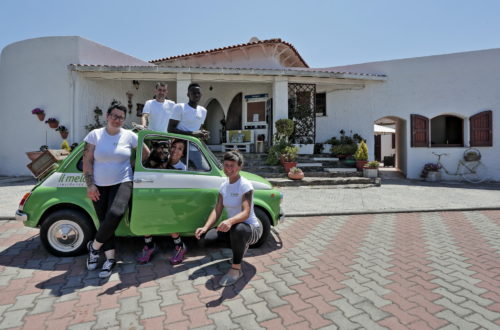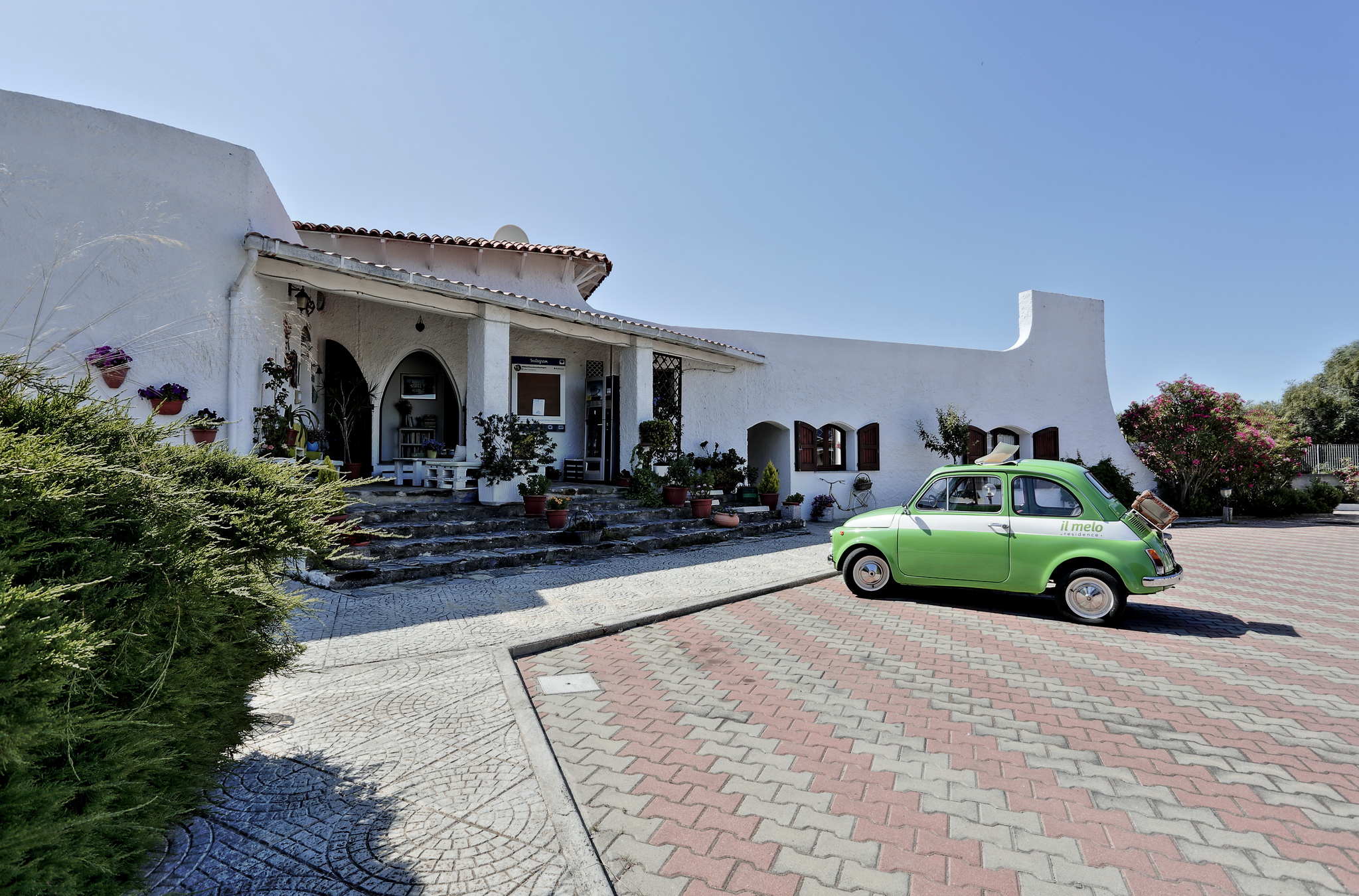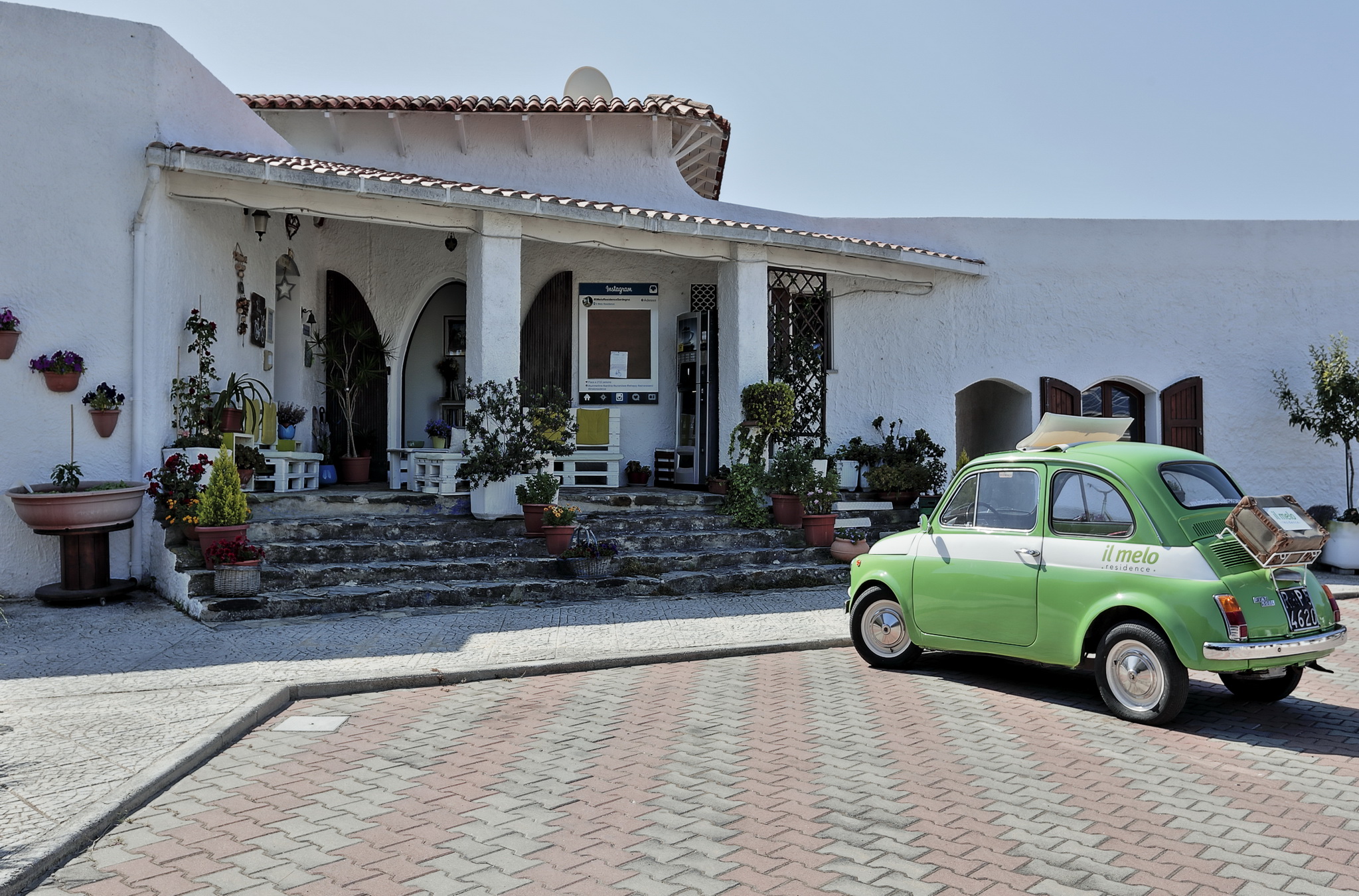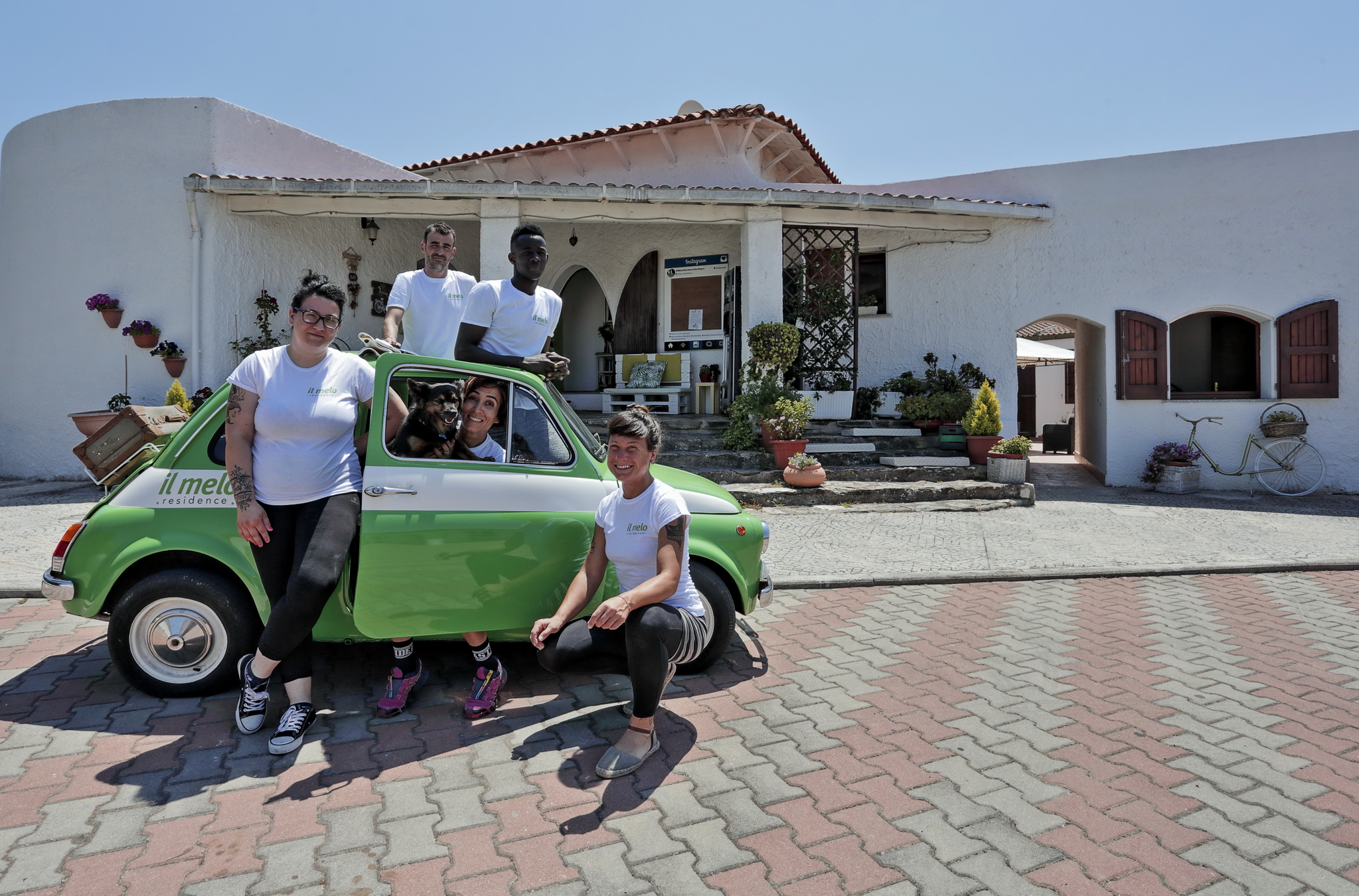A warm welcome to northern Sardinia

As soon as you make your way through the gates, something changes: maybe it’s the walls that embrace and protect the entire property, or maybe it’s the dedication and enthusiasm with which we take care of the hotel, the garden and our guests. Or maybe it’s because of the iodine in the sea air, because here we seem to be breathing the air of a little world apart, where peace and quiet reign.
Il Melo Residence was established as an accommodation provider in 2004, although the property’s fascinating history can be traced back to the late 1960s, when it went by another name and was renowned throughout the province as a dancehall. What remain from those days are the buildings, which recall a home located in the Andalucian countryside.
Over time, the accommodation offering has been expanded, and today it encompasses a total of twelve exceptionally comfortable two-room apartments (complete with hob, terrace, air conditioning, WiFi, TV, linen and laundry service, sun loungers and deckchair on request), an indoor car park and an attractive garden in which to pause for a chat or just to enjoy the sun.
The History of Il Melo Residence
When Il Melo was known as El Cordobes, and was not yet an accommodation provider, the town of Porto Torres, where the countryside ends, was considered the back of beyond, and played host to just one hotel.
The terrain was stony and barren, battered by a wind that here and there encountered rockrose and helichrysum, the odd rock and perhaps the remains of a Roman-era quarry, before reaching the sea at Balai Lontano. There were only a handful of dirt roads, but people came here all the same, because they wanted to dance.
El Cordobes was first and foremost an ambitious, dramatic and successful toreador, who won over the public in the 1960s and ’70s. He achieved a true economy of movement, which he put into practice as he challenged the beast. El Cordobes was a peer of Giovanni Congiatu, who was a surveyor from Porto Torres – that same town which, in 1968 at least, ran out of steam near the old cemetery.
A dancehall – that’s what’s missing around these parts.
This is what Giovanni and his two friends, Battista and Salvatore Scarpa, all aged in their early 30s, said to each other as they travelled towards Cagliari. The plot was already in hand, Giovanni had bought it up some time before and he was ready to build on it. They bet on the success of the project. They created an apartment block with sinuous forms, featuring an internal courtyard, protected by rounded walls. In doing so, Giovanni had put into it something of his idea of Spain, but also of Sardinia’s then-nascent Costa Smeralda, as well as a bucketload of courage. All around there was nothing, aside from the Countess’s house across the way.
In November 1969, he opened the door of the dancehall he had named El Cordobes complete with its stylish lighting system purchased in Milan at a cost of 250,000 lire – and the music played by the dancehall’s DJ got all of the girls strutting their stuff. 300 people came, some of them unknown, including the odd politician, a few businessmen, but not the marshal of the Carabinieri because Giovanni had forgotten to invite him, much to the policeman’s chagrin. It was, nevertheless, a triumph, and the dancehall’s success continued for a few years. It attracted people from Porto Torres, Sassari and the neighbouring towns and villages, from the resorts of Platamona and Castelsardo, they even came from the oil tankers anchored in the Gulf, foreign crews, Norwegians and Russians, who soon got drunk. And tourists came, too.
In the summer 1969, the front pages of the local papers – so used to describing emigrations and the hopes of up-and-coming businesses – were awash with stories of the two million visitors who had arrived on the coasts of northern Sardinia. Ships from Porto Torres, Olbia and Golfo Aranci doubled the number of daily routes, visitors from Milan reached as far as Stintino, and Alghero was given the moniker of the golden gateway for tourism in Sardinia.
They danced every day.
At the tea dances, in the afternoon, or in the evening on Saturdays and Sundays, people would dance to the sounds of the orchestra or to the DJs armed with hundreds of 33 and 45 rpm records. Ballroom dancing, the Twist, the Hully Gully, Rock&Roll, masks, pirates and carnivals. The end of every evening was announced by a theme song in the form of an old Spanish song which of course was entitled Cordobes. The only enemy oft hose noisy evenings was the neighbour – a Countess who happened to be the wife of a well-known magistrate. On occasion the Carabinieri would put a stop to the ear-splitting entertainment of the revellers.
One night, Paola was amongst those who came to dance, and Giovanni fell head over heels in love with her. Agostino and Laura would come later.
In the early1970s, the oil crisis gripped the world, and in Italy local mayors and the powers that be brought in the first “Sundays on foot”, when car use was discouraged, and the initiative even reached Porto Torres. Getting to El Cordobes was no longer so easy, but above all Giovanni wanted to undertake other projects – he had never been very keen on managing, he liked to create things.
The running of the premises was taken over by others. Perhaps amongst the places that in the meantime had opened up nearby there was some jealousy, who knows what went on, but what Giovanni was sure of was that the massive fire of ’76 had been started maliciously. It devastated the premises. Giovanni had to dig deep, and Paola was with him now. The three entrepreneurs decide to take back control in an effort to bring back the glory days of El Cordobes. It was a partial success, but later they opted to have others take over once again.
From dancehall to nightclub.
This was how, in the 1980s, the El Cordobes became a nightclub. The hostesses arrived.
There were other nightclubs in the area. The most famous was the Plata Night, the island’s oldest, established in the 1950s in Platamona. Giovanni remembers that even famous TV presenter Mike Bongiorno had been there.
What ended up taking shape around these locales was not always a transparent, entirely legal environment. There were news stories that from time to time made reference to his or that nightclub. El Cordobes, too, went through some dark days. After the final period, the doors slammed shut and would remain shut for twenty years.
Every once in a while, amid the odd bit of rubble and smashed glass, Giovanni would go there over the years to let off steam. With a sledgehammer, he would demolish parts of the now-useless walls. Everything seemed lost, all that was left were the furnishings, scattered here and there, the records, the red and black paintings hung on the walls by the final owners, the table lamps, the pictures, the artefacts, relics of a distant idea. A lot had been stolen, taken away by unknown hands.
In 2004, from the ashes of El Cordobes, came Il Melo.
The design is totally different, the original walls have been rebuilt, the taverna – at one time an indoor dancehall – is just like it was back then, the Reception area is in the place of the ticket desk and the cloakroom, the outdoor ballroom is today the courtyard overlooked by five apartments.
Giovanni and Paola are about to open a hotel, and she is certainly not going to give anything less than her all. They look at each other at the office of the notary, who has just asked them what they intend to call the place: “It’s pretty unimaginative,” admits Giovanni, “but it’s the only thing that came into our minds then and there – the name of the street”.
Six hundred square meters of living space, eight apartments (today twelve); in the summer they will work with tourists, in the winter with the employees of the company.
“There are guests who have never stopped coming back since then”: Laura is in charge now, and she’s the one to confirm her father’s statistics.
On 18 May, 2009, she takes over the running from her parents and today il Melo is also an acid-green 1972 Fiat Cinquecento, which makes its way around the city, small as an apple, making quite a splash!
All that Laura remembers about El Cordobesis the time of its neglect, the carpet, a large aquarium, the gloomy walls.
Her Melo is a welcoming space of peace and flowers, with a homely feeling thanks to the white walls and the circular courtyards. It is still today the last building in a town that over many years has expanded to eventually reach it, without going beyond it. Outside its walls, the area is still full of shrubs, rockrose and helichrysum, stones and, of course, the sea; the old bullfighter seems, now at rest, to be savouring the panorama.



